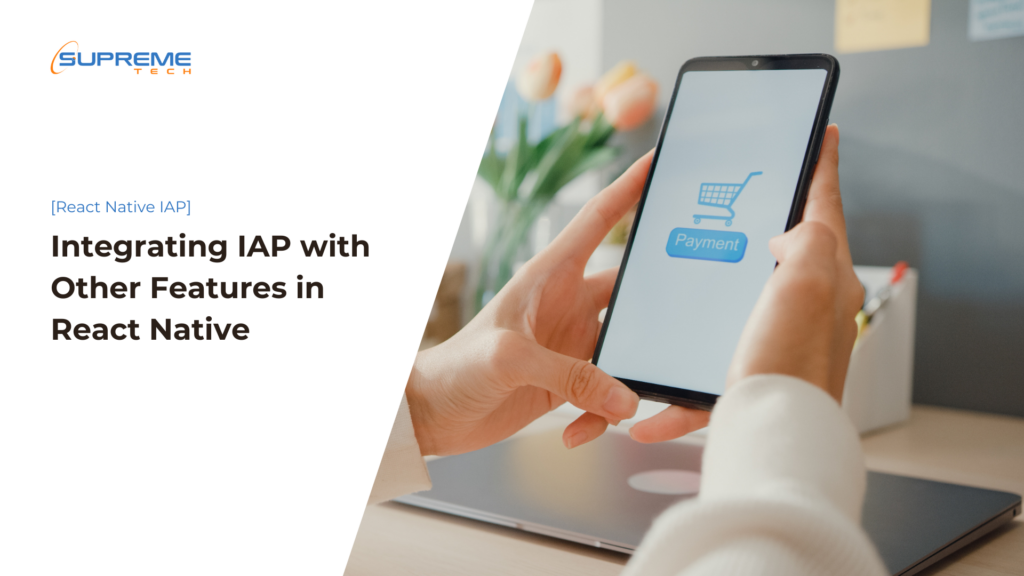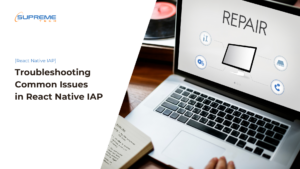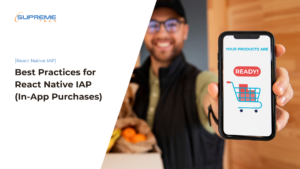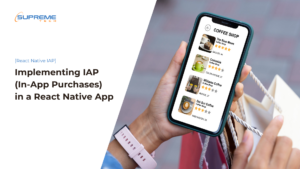Integrating IAP with Other Features in React Native
04/06/2024
1.41k
Following the series about React Native IAP (In-App Purchases), in this article we will discover how to integrate IAP with other features. Integrating In-App Purchases (IAP) with other features in a React Native application can enhance user engagement and maximize revenue. This article will explore how to combine IAP with other monetization methods, sync IAP data with backend services, and use IAP data to personalize user experiences. We’ll provide examples and code snippets to illustrate these integrations.
Let’s explore other articles in this series.
Implementing IAP (In-App Purchases) in a React Native App
Best Practices for React Native IAP (In-App Purchases)

Combining IAP with Other Monetization Methods
To diversify revenue streams, you can combine IAP with other monetization methods like ads and affiliate marketing.
Example: Combining IAP with Ads
You can offer an ad-free experience through IAP while still generating revenue from users who prefer the free version with ads.
- Integrate Ad SDK: Use a library like
react-native-google-mobile-adsto display ads.
import { BannerAd, BannerAdSize, TestIds } from '@react-native-google-mobile-ads';
const AdComponent = () => (
<BannerAd
unitId={TestIds.BANNER}
size={BannerAdSize.FULL_BANNER}
requestOptions={{
requestNonPersonalizedAdsOnly: true,
}}
/>
);
2. Offer Ad-Free Purchase: Create an in-app purchase for removing ads.
const productIds = ['com.example.remove_ads'];
const buyRemoveAds = async () => {
try {
await RNIap.requestPurchase(productIds[0]);
} catch (err) {
console.warn(err.code, err.message);
}
};
// Example button to trigger purchase
<Button title="Remove Ads" onPress={buyRemoveAds} />;
3. Conditional Rendering: Check if the user has purchased the ad-free version and conditionally render ads.
const [adsRemoved, setAdsRemoved] = useState(false);
useEffect(() => {
const checkPurchase = async () => {
const purchases = await RNIap.getAvailablePurchases();
setAdsRemoved(purchases.some(purchase => purchase.productId === productIds[0]));
};
checkPurchase();
}, []);
return (
<View>
{!adsRemoved && <AdComponent />}
{/* Other app components */}
</View>
);
Syncing IAP Data with Backend Services
Syncing IAP data with a backend service helps maintain user purchase records, validate transactions, and provide a seamless experience across devices.
- Backend Setup: Create a simple backend to handle receipt validation and store purchase data. Here’s an example using Node.js and Express:
const express = require('express');
const bodyParser = require('body-parser');
const app = express();
app.use(bodyParser.json());
app.post('/validate-receipt', async (req, res) => {
const { receipt } = req.body;
// Validate receipt with Apple/Google servers
const isValid = await validateReceiptWithStore(receipt);
if (isValid) {
// Store purchase data in database
await storePurchaseData(receipt);
res.json({ success: true });
} else {
res.json({ success: false });
}
});
const validateReceiptWithStore = async (receipt) => {
// Placeholder for actual validation logic
return true;
};
const storePurchaseData = async (receipt) => {
// Placeholder for storing data logic
};
app.listen(3000, () => console.log('Server running on port 3000'));
2. Client-Side Validation: Send the receipt to your backend for validation after a purchase.
const validateReceipt = async (receipt) => {
try {
const response = await fetch('https://your-server.com/validate-receipt', {
method: 'POST',
headers: {
'Content-Type': 'application/json',
},
body: JSON.stringify({ receipt }),
});
const result = await response.json();
return result.success;
} catch (error) {
console.warn('Validation error', error);
return false;
}
};
useEffect(() => {
const purchaseUpdateSubscription = RNIap.purchaseUpdatedListener(async (purchase) => {
const receipt = purchase.transactionReceipt;
if (receipt) {
const isValid = await validateReceipt(receipt);
if (isValid) {
// Complete the purchase
await RNIap.finishTransaction(purchase, false);
}
}
});
return () => {
purchaseUpdateSubscription.remove();
};
}, []);
Using IAP Data for Personalized User Experiences
IAP data can be leveraged to personalize the user experience, making the app more engaging and tailored to individual preferences.
- Unlocking Features: Use IAP to unlock premium features.
const [premiumUser, setPremiumUser] = useState(false);
useEffect(() => {
const checkPurchase = async () => {
const purchases = await RNIap.getAvailablePurchases();
setPremiumUser(purchases.some(purchase => purchase.productId === 'com.example.premium'));
};
checkPurchase();
}, []);
return (
<View>
{premiumUser ? (
<PremiumContent />
) : (
<RegularContent />
)}
</View>
);
2. Personalized Offers: Provide special offers based on past purchase behavior.
const [specialOffer, setSpecialOffer] = useState(null);
useEffect(() => {
const fetchSpecialOffer = async () => {
const purchases = await RNIap.getAvailablePurchases();
if (purchases.length > 0) {
// Fetch special offer from backend based on purchase history
const response = await fetch('https://your-server.com/special-offer', {
method: 'POST',
headers: {
'Content-Type': 'application/json',
},
body: JSON.stringify({ userId: user.id }),
});
const offer = await response.json();
setSpecialOffer(offer);
}
};
fetchSpecialOffer();
}, []);
return (
<View>
{specialOffer && <Text>{specialOffer.description}</Text>}
</View>
);
Conclusion
Integrating IAP with other features in a React Native app can greatly enhance user engagement and revenue. By combining IAP with ads, syncing purchase data with backend services, and using IAP data for personalization, you create a more dynamic and user-friendly experience. Following these practices ensures that your app not only generates revenue but also provides value to your users, leading to higher satisfaction and retention.






















